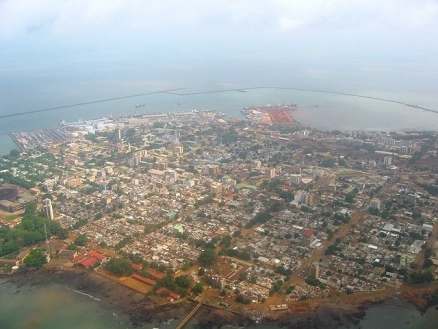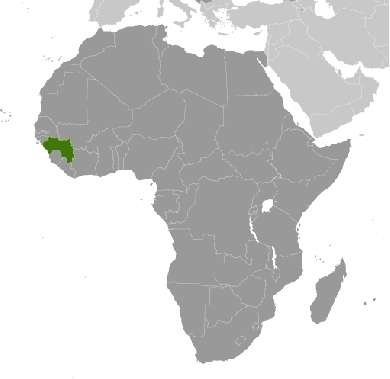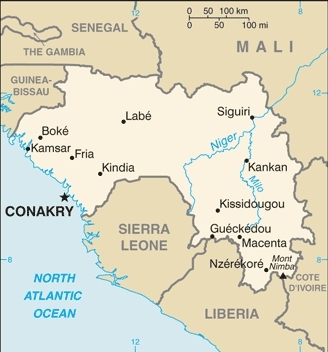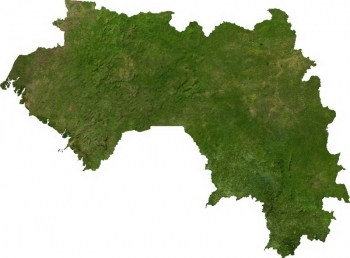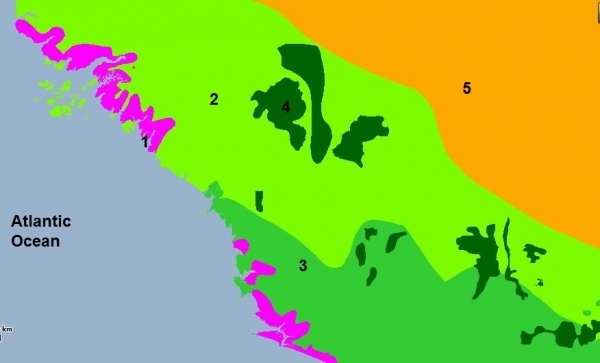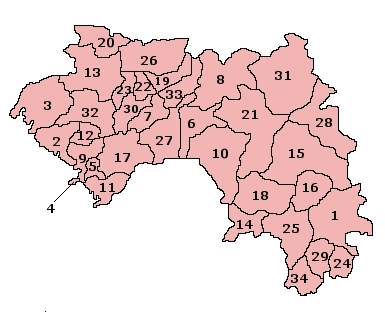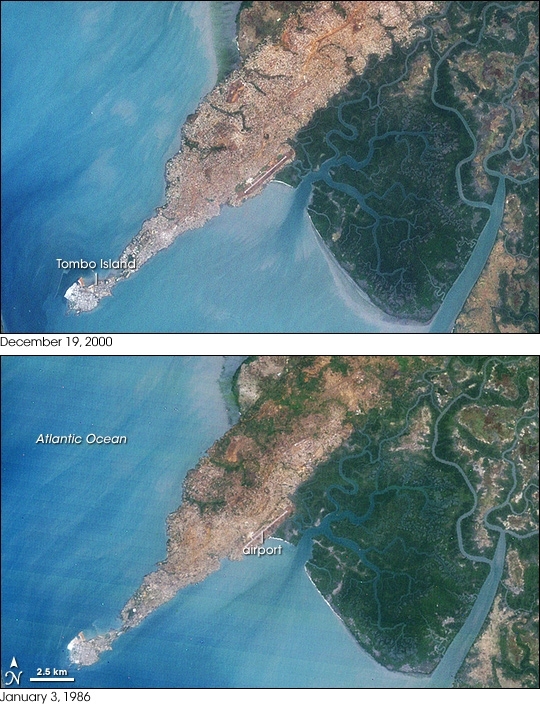Guinea
Guinea (formerly "French Guinea") is a nation of eleven million people in western-Africa, bordering the North Atlantic Ocean, between Guinea-Bissau and Senegal to the northwest and Sierra Leone, Liberia and Cote d'Ivoire to the south and east. Countries and Regions of the World Collection 
Guinea is generally a flat coastal plain, with a hilly to mountainous interior. The Niger River and its important tributary the Milo have their sources in the Guinean highlands.
Guinea's major environmental issues include:
- deforestation;
- inadequate supplies of potable water;
- desertification;
- soil contamination and erosion;
- overfishing,;
- overpopulation in forest region; and,
- poor mining practices have led to environmental damage.
It is susceptible to hot, dry, dusty harmattan haze which can reduce visibility during dry season.
Guinea has had a history of authoritarian rule since gaining its independence from France in 1958.
Lansana Conte came to power in 1984 when the military seized the government after the death of the first president, Sekou Toure. Guinea did not hold democratic elections until 1993 when Gen. Conte (head of the military government) was elected president of the civilian government. He was reelected in 1998 and again in 2003, though all the polls were marred by irregularities.
History repeated itself in December 2008 when following President Conte's death, Capt. Moussa Dadis Camara led a military coup, seizing power and suspending the constitution as well as political and union activity.
His unwillingness to yield to domestic and international pressure to step down led to heightened political tensions that culminated in September 2009 when presidential guards opened fire on an opposition rally killing more than 150 people, and in early December 2009 when Camara was wounded in an assassination attempt and evacuated to Morocco and subsequently to Burkina Faso.
A transitional government led by General Sekouba Konate held democratic elections in 2010 and Alpha Conde was elected president in the country's first free and fair elections since independence.
Contents
Geography
Guinea is located on the Atlantic Coast of West Africa and is bordered by Guinea-Bissau, Senegal, Mali, Cote d'Ivoire, Liberia, and Sierra Leone. The country is divided into four geographic regions: a narrow coastal belt (Lower Guinea); the pastoral Fouta Djallon highlands (Middle Guinea); the northern savannah (Upper Guinea); and a southeastern rainforest region (Forest Guinea). The Niger, Gambia, and Senegal Rivers are among the 22 West African rivers that have their origins in Guinea.
The coastal region of Guinea and most of the inland have a tropical climate, with a rainy season lasting from April to November, relatively high and uniform temperatures, and high humidity. Conakry's year-round average high is 29oC (85oF), and the low is 23oC (74oF); its average annual rainfall is 430 centimeters (169 inches). Sahelian Upper Guinea has a shorter rainy season and greater daily temperature variations.
Location: Western Africa, bordering the North Atlantic Ocean, between Guinea-Bissau and Sierra Leone
Geographic Coordinates: 11 00 N, 10 00 W
Area: 245,857 km2 (245,857 km2 land and 0 km2 water)
arable land: 4.47%
permanent crops: 2.64%
other: 92.89% (2005)
Land Boundaries: 3,399 km. Border countries: Cote d'Ivoire 610 km, Guinea-Bissau 386 km, Liberia 563 km, Mali 858 km, Senegal 330 km, Sierra Leone 652 km
Coastline: 320 km
Maritime Claims: Territorial sea to 12 nautical miles and an exclusive economic zone to 200 nautical miles
Natural Hazards: Hot, dry, dusty harmattan haze may reduce visibility during dry season
Terrain: Generally flat coastal plain, hilly to mountainous interior. Its lowest point is the Atlantic Ocean (0 metres) and its highest point is Mont Nimba (1,752 metres).
Climate: Generally hot and humid; monsoonal-type rainy season (June to November) with southwesterly winds; dry season (December to May) with northeasterly harmattan winds
Ecology and Biodiversitry
Ecoregions of Guinea. Source: World Wildlife Fund
- Guinean mangroves
- Guinean forest-savanna mosaic
- Western Guinean lowland forests
- Guinean montane forests
- West Sudanian savanna
See also:
- Biological diversity in the Guinean forests of West Africa
- Guinea Current large marine ecosystem
- Canary Current large marine ecosystem
- Mount Nimba Strict Nature Reserve, Guinea and Côte d'Ivoire
Deforestation in Guina's Parrot's Beak Area
In western Africa, a small part of Guinea juts southward into Sierra Leone just north of that country’s border with Liberia. The region is known as the “Parrot’s Beak” because of the curved point of land between the Meli and Mokona Rivers. According to the United Nations Environment Programme (UNEP), the unique forests of the region have dramatically diminished over the past few decades as civil war in Sierra Leone and Liberia have pushed tens and possibly hundreds of thousands of refugees into the Parrot’s Beak. People have cut down the forests for housing materials, wood for charcoal, and space to grow crops. Some commercial logging also played a role.
This pair of Landsat satellite images illustrates the deforestation that took place between December 19,1999 (top), and January 6, 1974 (bottom). In 1974, deep green forests covered much more of the region than they did in 1999. According to the UNEP book One Planet, Many People: Atlas of Our Changing Environment, refugees to Guinea ”integrated into local villages, created their own family plots, and expanded the Existing zones of converted forest area until they all merged.” Indeed, the 1999 image appears to be the inverse of the 1974 image. In 1974, small village clearings (appearing light green or tan) are surrounded by green forests; in 1999, small islands of dark green forest are surrounded by mostly cleared land. Source:NASA
People and Society
Population: 10,884,958 (July 2012 est.)
Guinea has four main ethnic groups: Peuhl (Foula or Foulani), who inhabit the mountainous Fouta Djallon; Malinke (or Mandingo), in the savannah and forest regions; Soussous in the coastal areas; and several other ethnic groups (Gerze, Toma, etc.) in the forest region.
Other West Africans make up the largest non-Guinean population. Non-Africans total about 10,000 (mostly Lebanese, French, and other Europeans). Seven national languages are used extensively; major written languages are French and Arabic.
Ethnic groups: Peuhl 40%, Malinke 30%, Soussou 20%, smaller ethnic groups 10%
Age Structure:
0-14 years: 42.5% (male 2,278,048/female 2,229,602)
15-64 years: 54% (male 2,860,845/female 2,860,004)
65 years and over: 3.5% (male 164,051/female 208,459) (2011 est.)
Population Growth Rate: 2.641% (2012 est.)
Birth Rate: 36.6 births/1,000 population (2012 est.)
Death Rate: 10.19 deaths/1,000 population (July 2012 est.)
Net Migration Rate: 0 migrant(s)/1,000 population (2012 est.)
Life Expectancy at Birth: 58.61 years
male: 57.12 years
female: 60.15 years (2012 est.)
Total Fertility Rate: 5.04 children born/woman (2012 est.)
Languages: French (official); note - each ethnic group has its own language
Literacy (2003 est.): 29.5% (male: 42.6% - female: 18.1%)
Urbanization: 35% of total population (2010) growing at an annual rate of change of 4.3% (2010-15 est.)
History
The area occupied by Guinea today was included in several large West African political groupings, including the Ghana, Mali, and Songhai empires, at various times from the 10th to the 15th century, when the region came into contact with European commerce. Guinea's colonial period began with French military penetration into the area in the mid-19th century. French domination was assured by the defeat in 1898 of the armies of Almamy Samory Toure, warlord and leader of Malinke descent, which gave France control of what today is Guinea and adjacent areas.
France negotiated Guinea's present boundaries in the late 19th and early 20th centuries with the British for Sierra Leone, the Portuguese for their Guinea colony (now Guinea-Bissau), and Liberia. Under the French, the country formed the Territory of Guinea within French West Africa, administered by a governor general resident in Dakar. Lieutenant governors administered the individual colonies, including Guinea.
Led by Ahmed Sekou Toure, head of the Democratic Party of Guinea (PDG), which won 56 of 60 seats in 1957 territorial elections, the people of Guinea in a September 1958 plebiscite overwhelmingly rejected membership in the proposed French Community. The French withdrew quickly, and on October 2, 1958, Guinea proclaimed itself a sovereign and independent republic, with Sekou Toure as President.
Under Toure, Guinea became a one-party dictatorship, with a closed, socialized economy and no tolerance for human rights, free expression, or political opposition, which was ruthlessly suppressed. Originally credited for his advocacy of cross-ethnic nationalism, Toure gradually came to rely on his own Malinke ethnic group to fill positions in the party and government. Alleging plots and conspiracies against him at home and abroad, Toure's regime targeted real and imagined opponents, imprisoning many thousands in Soviet-style prison gulags, where many perished. The regime's repression drove more than a million Guineans into exile, and Toure's paranoia ruined relations with foreign nations, including neighboring African states, increasing Guinea's isolation and further devastating its economy.
Sekou Toure and the PDG remained in power until his death on April 3, 1984. A military junta--the Military Committee of National Recovery (CMRN)--headed by then-Lt. Col. Lansana Conte, seized power just 1 week after the death of Sekou Toure. The CMRN immediately abolished the constitution, the sole political party (PDG) and its mass youth and women's organizations, and announced the establishment of the Second Republic. In lieu of a constitution, the government was initially based on ordinances, decrees, and decisions issued by the president and various ministers.
Political parties were proscribed. The new government also released all prisoners and declared the protection of human rights as one of its primary objectives. It reorganized the judicial system and decentralized the administration. The CMRN also announced its intention to liberalize the economy, promote private enterprise, and encourage foreign investment in order to develop the country's rich natural resources.
The CMRN formed a transitional parliament, the "Transitional Council for National Recovery" (CTRN), which created a new constitution (La Loi Fundamental) and Supreme Court in 1990. The country's first multi-party presidential election took place in 1993. These elections were marred by irregularities and lack of transparency on the part of the government. Legislative and municipal elections were held in 1995. Conte's ruling Party for Unity and Progress (PUP) won 76 of 114 seats in the National Assembly, amid opposition claims of irregularities and government tampering. The new National Assembly held its first session in October 1995.
Several thousand malcontent troops mutinied in Conakry in February 1996, destroying the presidential offices and killing several dozen civilians. Mid-level officers attempted, unsuccessfully, to turn the rebellion into a coup d'etat. The Government of Guinea made hundreds of arrests in connection to the mutiny, and put 98 soldiers and civilians on trial in 1998. A number of them were executed.
In December 1998, Conte was reelected to another 5-year term in a flawed election that was, nevertheless, an improvement over 1993. Following his reelection and the improvement of economic conditions through 1999, Conte reversed direction, making wholesale and regressive changes to his cabinet. He replaced many technocrats and members of the Guinean diaspora that had previously held important positions with "homegrown" ministers, particularly from his own Soussou ethnic group. These changes led to increased cronyism, corruption, and a retrenchment on economic and political reforms.
Despite his failing health, in December 2003, President Conte easily won a third presidential term against a single, relatively unknown candidate after the opposition parties boycotted the elections. Conte insisted in a late 2006 interview that regardless of his health he would remain in office until his term ended in 2010.
In 2006 and 2007, Guinea's labor union alliance launched a series of historic, increasingly violent labor strikes. Whereas the unions' demands during the March and June 2006 strikes were primarily economic, the January 2007 strike was more political. Security forces were responsible for the deaths of several protesters in June 2006. The 2007 strike also turned violent after President Conte ignored the unions’ demand that he resign from office. Nationwide, protesters began barricading roads, throwing rocks, burning tires, and skirmishing with police. Violence peaked on January 22 when several thousand ordinary Guineans poured into the streets, primarily in the capital, calling for change. Guinean security forces and the military's "red beret" presidential guard reacted by opening fire on the peaceful crowds.
On January 27, 2007, unions, employers associations, and the government entered a tripartite agreement to suspend the strike. President Conte agreed to name a new "consensus" prime minister, with delegated executive powers. For the first time, the new prime minister of Guinea would carry the title of "head of government" and exercise certain powers previously held by the president of the republic. However, President Conte's February 9 appointment of a longtime associate, Eugene Camara, as Guinea's new prime minister sparked another wave of violence and protests. In an attempt to quell the violence, on February 12 President Conte declared a "state of siege," which conferred broad powers on the military, and implemented a strict curfew. According to media reports, the following days saw military and police forces scour Conakry and towns in the hinterlands where they committed serious human rights abuses.
When Guinea's National Assembly rejected Conte's effort to extend the "state of siege," it became clear that the popular protests had widespread support, even among leaders of Conte's own ruling party. Soon after, an Economic Community of West African States (ECOWAS) delegation led by former Nigerian President Babangida announced that President Conte had agreed to name a new "consensus" prime minister in consultations with the unions and civil society. Lansana Kouyate arrived in Conakry on February 27, 2007, just hours after being announced as the new Prime Minister and head of the government. Security forces are believed responsible for having killed at least 137 people and injuring more than 1,700 others during the strike-related violence in January and February 2007.
During his premiership, Kouyate faced constant speculation that the president and his associates opposed his reform efforts. His failure to alleviate social and economic conditions contributed to the steady decline of his popularity. In May 2008, President Conte replaced Kouyate with Ahmed Tidiane Souare, a former minister of mines from a previous cabinet. The Souare administration quickly began to reinstate presidential loyalists. President Conte's death on December 22, 2008 sparked an immediate coup d’etat by elements of the military.
Captain Moussa Dadis Camara seized power on December 23, 2008, declaring himself President of the Republic and suspending the constitution, but promising elections and an eventual restoration of civilian authority. By August 2009, it was increasingly clear that Camara intended to run for president. In response, Guinea’s opposition coalition, Les Forces Vives, organized a protest on September 28, 2009, which attracted tens of thousands of protesters to the national stadium in Conakry. The Guinean military responded by opening fire on the crowd, killing at least 157 protesters, wounding more than a 1,000 others, and sexually assaulting more than 100 women, triggering widespread condemnation from the international community and increasing isolation for the junta. On December 3, 2009, Camara was wounded by his aide-de-camp in a failed assassination attempt and evacuated to Morocco for medical treatment. National Council for Democracy and Development (CNDD) Minister of Defense Brigadier General Sekouba Konate stepped in as interim President of the Republic. Camara’s wounds were not fatal, but necessitated a prolonged period of rehabilitation.
Camara was flown to Ouagadougou in January 2010, at the invitation of Burkinabe President Blaise Compaore, the ECOWAS-appointed mediator to the Guinean political crisis. Compaore helped broker a deal between Camara and Konate, known as the January 15 Ouagadougou Accords, in which Camara agreed to remain outside of Guinea for an extended recuperation and to officially appoint General Konate as the interim President of the Republic. Konate appointed former speaker for Les Forces Vives, Jean Marie Dore, as Prime Minister. In February, Dore formed a government that included 11 ministers from political parties, 11 from civil society, and 11 from the junta government. In addition, a National Transition Council (CNT) consisting of 150 members from civil society, labor unions, political parties, the private sector, security forces, and other important organizations, was formed to act as the legislative body until legislative elections could be held. The CNT rewrote and enacted the constitution in March. It also enacted new electoral and media codes.
On June 27, Guinea had its first round of presidential elections, with 24 candidates running for the office of President. As per the Ouagadougou Accords, no member of the military or the transition government ran in the elections. International and national observer groups declared the elections credible and fair, though they cited major technical problems that needed to be addressed before the second round could credibly take place. Cellou Dalein Diallo of the Union of Democratic Forces of Guinea (UFDG) party received 43% of the vote; Alpha Conde of the Rally for the Guinean People (RPG) party received 18%; and Sidya Toure of the Union of Republican Forces (UFR) party received 13%. Diallo and Conde went on to compete in the second round of elections that, after several delays, took place on November 7. In the weeks leading up to and immediately after the elections, ethnic violence broke out between the Peuhl and Malinke support bases of the two candidates, resulting in several hundred internally displaced people and at least a dozen deaths. The transition government imposed a state of emergency and imposed a curfew, which successfully stopped the violence.
On December 2, the Guinean Supreme Court determined Alpha Conde the winner of the elections with 53% of the vote, which was declared free and credible by international observer missions. On December 3, Cellou Diallo publicly accepted the results of the election and called for his supporters to support the newly elected president. President Conde was peacefully inaugurated on December 21, 2010. On December 24, Mohamed Said Fofana, an economist, was appointed as Guinea’s Prime Minister.
After inauguration, the government lifted security checkpoints throughout the country. Following a July 19, 2011 attack on the president’s personal residence, the government temporarily reinstated the checkpoints, citing security concerns. By the end of July the checkpoints were reduced to operating during the hours of 11:00 p.m. to 6:00 a.m.
Although legislative elections were mandated to take place 6 months after the completion of presidential elections, as of November 2011 legislative elections had not yet been held. The Independent National Commission for Elections announced that elections would take place on December 29, 2011, but election experts and outside observers stated that the commission’s timeline was unrealistic and elections would not take place in 2011.
Government
Until the December 23, 2008 coup d’etat, Guinea was a constitutional republic in which effective power was concentrated in a strong presidency. A new constitution was passed and enacted by the National Transition Council (CNT) in March 2010. A civilian president governs Guinea with the assistance of a civilian prime minister. Alpha Conde's government, elected in late 2010, promised to hold legislative elections that were previously scheduled for 2007. Until a legislature is installed, the CNT acts as Guinea’s legislative body.
Government administration is carried out at several levels; in descending order, they are: eight regions, 33 prefectures, over 100 subprefectures, and many districts (known as communes in Conakry and other large cities, and villages or "quartiers" in the interior). District-level leaders are elected; the president appoints officials to all other levels of the highly centralized administration. The population is politically and ethnically divided, but the political atmosphere is currently calm.
Government Type: Republic
Capital: Conakry - 1.597 million (2009)
Administrative Divisions: 33 prefectures and 1 special zone (zone special)*;
|
1. Beyla |
18. Kissidougou |
Independence Date: 2 October 1958 (from France)
Legal System: based on French civil law system, customary law, and decree. Guinea accepts compulsory International court of Justice (ICJ) jurisdiction with reservations; and, accepts International criminal court (ICCt) jurisdiction.
Suffrage: 18 years of age; universal
Africa’s coastal country of Guinea is nicknamed the “water tower of Africa,” thanks to the more than 20 rivers originating inside its borders, as well as its relatively high precipitation. Mangroves line much of Guinea’s coast, but a 2008 report issued by the United Nations Environment Programme (UNEP) outlined growing pressure placed on these forests by the local population, especially after an influx of refugees from Liberia and Sierre Leone in the 1990s.
The city of Conakry, Guinea, originated on Tombo Island and spread up the Kaloum Peninsula, sandwiched between mangrove swamps. In the 1960s, the city had a population of fewer than 40,000; in 2006, it had a population of nearly 2 million. These natural-color images, acquired by NASA’s Landsat satellites, show the city’s dramatic growth from 1986 to 2000. Land and water features look similar to how they would look in a photograph by a digital camera. Water ranges in color from deep to pale blue, vegetation appears dark green, and bare ground and urbanized areas range in color from gray to beige to reddish-brown.
In the bottom image, acquired on January 3, 1986, the urbanized area stretches from Tombo Island past Conakry International Airport, yet vegetation remains on much of the peninsula. Urbanization concentrates on the southeastern side of the peninsula as fingers of vegetation wriggle inland from the northwest. In the top image, acquired on December 19, 2000, the fingers of vegetation have thinned to nearly nothing, and the city has spread all the way up the peninsula. Mangroves persist on either side of the city, but according to UNEP, the mangroves were being cleared for agriculture and harvested for firewood.
Besides reporting growing urbanization, UNEP also reported Guinea’s progress in environmental sustainability. Between 1990 and 2005, the proportion of protected land area increased, as did access to improved sources of drinking water and sanitation. Per capita carbon dioxide emissions and the percentage of urban dwellers living in slums decreased during the same period. Source: NASA. NASA image created by Jesse Allen, using Landsat data provided by the United States Geological Survey. Caption by Michon Scott.
International Environmental Agreements
Guinea is party to intenational agreements on: Biodiversity, Climate Change, Climate Change-Kyoto Protocol, Desertification, Endangered Species, Hazardous Wastes, Law of the Sea, Ozone Layer Protection, Ship Pollution, Wetlands, and Whaling.
Water
Total Renewable Water Resources: 226 cu km (1987)
Freshwater Withdrawal: Total: 1.51 cu km/yr (8% domestic, 2% industrial, 90% agriculture).
Per Capita Freshwater Withdrawal: 161 cu m/yr (2000)
Access to improved drinking water sources: 71% of population
Access to improved sanitation facilities: 19% of population
Agriculture
Agricultural Products: rice, coffee, pineapples, palm kernels, cassava (tapioca), bananas, sweet potatoes; cattle, sheep, goats; timber
Irrigated Land: 950 sq km (2003)
Resources
Natural Resources: bauxite, iron ore, diamonds, gold, uranium, hydropower, fish, salt.
Energy
| Energy in Guinea | |||||
| Production | Consumption | Exports | Imports | Reserves | |
| Electricity | 920 million kWh | 855.6 million kWh (2009 est.) |
0 kWh (2009) |
0 kWh (2009) |
|
| Oil | 0 bbl/day (2010 est.) |
9,000 bbl/day (2010 est.) |
0 bbl/day (2009) |
8,559 bbl/day (2009 est.) |
0 bbl (1 January 2011 est.) |
| Natural Gas | 0 cu m (2009 est.) |
0 cu m (2009 est.) |
0 cu m (2009 est.) |
0 cu m (2009) |
0 cu m (1 January 2011 est.) |
| Source: CIA Factbook | |||||
Economy
Guinea is a poor country that possesses major mineral, hydropower, and agricultural resources. However, Guinea has been unable to profit from this potential, as rampant corruption, dilapidated infrastructure, and political uncertainty have drained investor confidence.
Richly endowed with minerals, Guinea possesses over 25 billion metric tons (MT) of bauxite--and perhaps up to one-half of the world's readily exploitable reserves. Guinea's mineral wealth also includes more than 4 billion tons of high-grade iron ore, significant diamond and gold deposits, and undetermined quantities of uranium. Guinea has considerable potential for growth in the agricultural and fishing sectors. Soil, water, and climatic conditions provide opportunities for large-scale irrigated farming and agro industry.
Possibilities for investment and commercial activities exist in all these areas, but Guinea's poorly developed infrastructure and rampant corruption continue to present obstacles to large-scale investment projects. Despite the opening in 2005 of a new road connecting Guinea and Mali, most major roadways connecting the country's trade centers remain in poor repair, slowing the delivery of goods to local markets. Electricity and water shortages are frequent and sustained, and many businesses are forced to use expensive power generators and fuel to stay open. Growth in 2010 was 2%, and the informal sector continues to be a major contributor to the economy. Exchange rate stability is an ongoing concern.
President Conde's government, elected in late 2010, promised to make reforms including combating government corruption, rebuilding Guinea’s degraded transportation infrastructure, and improving access to electricity and potable water. The Conde administration also plans to revise Guinea’s investment code in 2011 or 2012.
Mining
Joint venture bauxite mining and alumina operations in northwest Guinea historically provided about 80% of Guinea's foreign exchange. The Compagnie des Bauxites de Guinea (CBG) is the main player in the bauxite industry. CBG is a joint venture, in which 49% of the shares are owned by the Guinean Government and 51% by an international consortium led by Alcoa and Rio Tinto-Alcan. CBG exports about 14 million MT of high-grade bauxite every year. The Compagnie des Bauxites de Kindia (CBK), a joint venture between the Government of Guinea and Russki Alumina (Rusal), produces some 3.1 million MT annually, nearly all of which is exported to Russia and Eastern Europe. Dian Dian, a Guinean/Ukrainian joint bauxite venture, has a projected production rate of 1 million MT per year, but is not expected to begin operations for several years. The Alumina Compagnie de Guinee (ACG), a subsidiary of Rusal which took over the former Friguia Consortium, produced about 2 million MT of bauxite in 2010, which is used as raw material for its alumina refinery. The refinery supplies about 640,000 MT of alumina for export to world markets. Both the Alcoa-Rio Tinto-Alcan consortium and the Guinea Alumina Corporation (GAC)--whose stakeholders include BHP-Billiton, the Global Alumina Corporation, the Dubai Alumina Corporation, and Abu Dhabi’s Mubadala Development Company--have signed conventions with the Government of Guinea to build large alumina refineries with a combined capacity of about 4 million MT per year.
Diamonds and gold also are mined, though Guinea’s potential in these two industries has been historically underdeveloped. By far, most diamonds are mined artisanally. The largest gold mining operation in Guinea is a joint venture between the government and Ashanti Gold Fields of Ghana. Societe Miniere de Dinguiraye (SMD) also has a large gold mining facility in Lero near the Malian border as does SEMAFO, a Canadian-based gold mining company.
In 2004, the GAC joint venture began feasibility studies on a 650 sq. km bauxite mining site. In 2008, the company started the “early works” phase of the project, which includes infrastructure construction on the mining site, the refinery facility, and a transportation network. Alcoa and Rio Tinto-Alcan are also in the early construction phase of a smaller refinery in the area. Taken together, they represent the largest private investment in sub-Saharan Africa since the Chad-Cameroun oil pipeline, and could see a 40% increase in Guinea’s bauxite production upon completion. The $5 billion GAC project continued to move slowly in 2011 due to falling commodity prices, shareholder disagreements, and uncertainty about the regulatory environment. Though production from the site was originally scheduled to commence in mid-2012, it is not likely to reach the production stage until 2015.
Rio Tinto signed an agreement with the Government of Guinea in 2003 to develop a 110 sq. km iron mine in Simandou. In December 2008, the government announced that it would be revoking part of Rio Tinto’s Simandou contract. The site remained in dispute until April 2011, when Rio Tinto signed an agreement with the government to develop its two remaining blocks of Simandou in exchange for a $700 million payment to the government. As of October 2011 the company had invested nearly $3 billion in feasibility studies and early development of the mining site and associated infrastructure.
Reform Efforts
The Guinean Government adopted policies in the 1990s to return commercial activity to the private sector, promote investment, reduce the role of the state in the economy, and improve the administrative and judicial framework after decades of socialism under President Sekou Toure. Despite the initial success of these programs to promote economic growth, changes in policy over the following decade up to President Conte’s 2008 death made little headway in addressing the structural problems afflicting Guinea’s private sector, although there was some growth.
The government revised the private investment code in 1998 to stimulate economic activity in the spirit of free enterprise. The code did not discriminate between foreigners and nationals and provided for repatriation of profits. While the code restricted development of Guinea's hydraulic resources to projects in which Guineans have majority shareholdings and management control, it did contain a clause permitting negotiations of more favorable conditions for investors in specific agreements. Foreign investments outside Conakry were entitled to more favorable benefits. A national investment commission was formed to review all investment proposals. The United States and Guinea signed an investment guarantee agreement offering political risk insurance to American investors through the Overseas Private Investment Corporation (OPIC). In addition, Guinea inaugurated an arbitration court system to allow for the quick resolution of commercial disputes.
Until June 2001, private operators managed the production, distribution, and fee-collection operations of water and electricity under performance-based contracts with the Government of Guinea. However, with both utilities plagued by inefficiency and corruption, foreign private investors in these operations departed the country in frustration.
In 2002, the International Monetary Fund (IMF) suspended Guinea's Poverty Reduction and Growth Facility (PRGF) because the government failed to meet key performance criteria. In reviews of the PRGF, the World Bank noted that Guinea had met its spending goals in targeted social priority sectors. However, spending in other areas, primarily defense, contributed to a significant fiscal deficit. The loss of IMF funds forced the government to finance its debts through Central Bank advances. The pursuit of unsound economic policies resulted in hard-to-correct imbalances.
Under Prime Minister Diallo, the government began a rigorous reform agenda in December 2004 designed to return Guinea to a PRGF with the IMF. Although exchange rates temporarily improved, these reforms did not slow down inflation, which hit 27% in 2004, 30% in 2005 and, according to the Economist Intelligence Unit, 34.7% in 2006 and 23.4% in 2007. In 2007, the IMF launched a new PRGF for Guinea to support a 3-year IMF program with the objective of reducing poverty and securing debt relief for the country under the Heavily Indebted Poor Countries (HIPC) initiative. As of late 2008, Guinea was on track to achieve debt reduction under the HIPC initiative. However, after the December 23, 2008 coup d’etat, the status of the HIPC program was unclear. In 2009, both the World Bank and the IMF stopped their programming to Guinea.
Investment and economic growth slowed considerably in 2009 due to falling commodity prices, the global economic crisis, and CNDD economic mismanagement. After seizing power, CNDD President Moussa Dadis Camara declared that all commercial contracts negotiated under the former regime would be subject to immediate audit and review. Camara waged several contract campaigns in his first 6 months in power against large international mining companies including Rio Tinto, Rusal, and AngloGold Ashanti. From September 2009, the insecurity created by government hostility toward investment was compounded by violent political crackdowns and fracturing within the military. Many companies already operating in Guinea slowed exploration efforts considerably for fear that falling prices and government intervention could precipitate massive investment losses. New investments also decreased significantly in 2009.
In the wake of Guinea’s first democratic elections, international interest in Guinea is on the rise. Following the release of Guinea’s new mining code in September 2011, mining companies are beginning to restart their projects, and investors are arriving with interest in Guinea’s overall economic potential and opportunities in the minerals sector. The World Bank and IMF restarted operations in Guinea in June 2011. The World Bank committed $140 million to development projects in 2011 and 2012, and the IMF initiated a Staff Managed Program designed as a bridge to the establishment of an Extended Credit Facility (ECF), a requirement for HIPC completion. As of October 2011, experts said Guinea might be able to begin the ECF by January 2012 and could qualify for debt relief under HIPC by July 2012. Although progress on economic reform and reengaging with international partners has been slow, as of November 2011 President Conde seemed to be following through with his promise to make Guinea’s economic development his top priority.
GDP (Purchasing Power Parity): $11.53 billion (2011 est.)
GDP (Official Exchange Rate): $4.6 billion (2011 est.)
GDP- per capita (PPP): $1,100 (2011 est.)
GDP- composition by sector:
agriculture: 16.8%
industry: 53.5%
services: 29.7% (2011 est.)
Population Below Poverty Line: 47% (2006 est.)
Industries: bauxite, gold, diamonds, iron; alumina refining; light manufacturing, and agricultural processing
Exports: bauxite, alumina, gold, diamonds, coffee, fish, agricultural products
Imports: petroleum products, metals, machinery, transport equipment, textiles, grain and other foodstuffs
Currency: Guinean franc (GNF)
Ports and Terminals: Conakry, Kamsar
